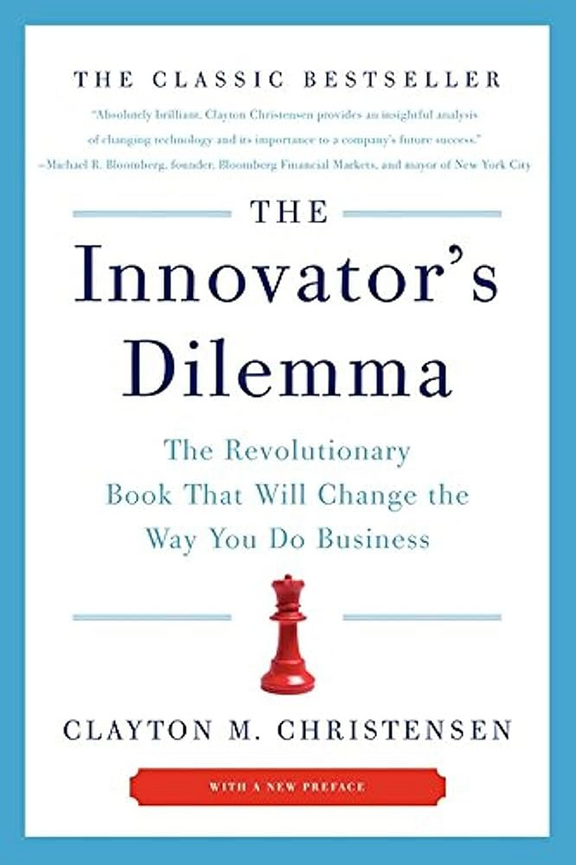AI startups require new strategies: This time it’s actually different
Startups must leverage their specific advantages they have over incumbents to overcome the massive barriers erected by those incumbents: Mature products, mature distribution channels, brand, trust, optimized organizations, and cash in the bank.
However, in the AI revolution many of those advantages are unavailable. Some even become a disadvantage. This is substantively different from the other two major technological revolutions of the past twenty-five years.1
1 The Internet and mobile devices. Not blockchain, at least not yet—that has had almost no effect on businesses despite the application of billions of dollars over more than a decade.
Specifically:
- Disruption Theory & risk-aversion don’t apply
- Incumbents typically cede market space to startups wherever there’s new, unproven technology or a new, unproven market, especially in spaces where they can’t use past data to predict the future. But in AI, they’re rushing to embrace new technology and uncertain markets, spending historic amounts of money and time.
- Incumbents aren’t failing to innovate
- Typically the race is “whether the startup gets distribution before the incumbent gets innovation ( Alex Rampell).” But in AI, the incumbents already have the innovation (whether through closed APIs or open source), while startups struggle as mightily as ever to find distribution. Perhaps an even greater struggle, as every market is over-saturated with new startup competitors, some with massive funding.
- Incumbents have the data
- “There’s no AI strategy without a data strategy,” the (now often-repeated) saying goes. For training, testing, benchmarking, and features, you need data. Incumbents have it or can afford it; startups are at another disadvantage.
- Great talent are happy at incumbents
- While there will always be fantastic people who only want to be at a small company, there are even more people, including the top AI and software engineering talent in the world, who are getting paid above-market rates to work on the most exciting projects, with healthy budgets, with data to leverage, and with the ability to impact huge numbers of customers quickly without having to do marketing, sales, support, or accounting.
- The so-called “AI market” is not what you think it is
- People say “the AI market will be trillions of dollars so there’s enough for everyone,” but there’s no such thing as “the AI market” unless you’re competing directly with OpenAI. The market for chatbots and SEO tools is the same market as before, now with stiffer competition.
The typical startup strategies are wrong because typical strategies rely on the typical advantages of David against Goliath, which are largely untrue in AI. If strategy is “how we will win,” then the “how” must be different with AI.
Few AI startups have embraced this reality, and most will fail as a result. It is easy to create an AI startup, gain attention, and generate excitement, but it is much more challenging to compete and win.
The remainder of the article details and defends this case.
Disruption Theory does not apply to AI
The Innovator’s Dilemma is not a dilemma this time around.

Disruption Theory explains how little upstarts leverage new technology to topple incumbents, even though the incumbents see it coming and act in their rational self-interest.
The theory goes: New technology is often (a) better in some ways, (b) worse in some ways, and (c) cheaper than existing technology. The combination of (a) and (c) can overcome (b). The classic example given in the book is the original transistor radio, whose the sound quality was far worse than the incumbent, beautiful-to-look-at, rich-sounding, furniture-sized-and-weight RCA radios. However, the advantage of the transistor radio is that it is portable, a feature made possible because transistors use so little energy. A radio at the beach that’s staticky and a tinny is a lot better than not having a radio at all. So, upstarts were able to sell radios that were worse in a very important way, but also cheaper and with the advantage of mobility.
Of course, over time, the transistor radio improved its sound quality, and this is the other factor in Disruption Theory: The technology that starts out worse becomes better over time, and yet is still cheaper and retains its positive qualities. Then the new technology fully disrupts the incumbents, who had been looking on, thinking “we’re the ones who have great sound, so we’re safe. We’re not even really competing with those toy radios.”
Disruptions start “worse,” but then become even better than incumbents
In AI, the conditions of Disruption Theory are not present.
The incumbents do not look at AI and say “this technology is cheaper but worse, so we will ignore it.” They’re doing just the opposite. They say “this technology is groundbreaking and if we don’t embrace it, we will become irrelevant” and “our shareholders are demanding that we invest huge percentages of our annual revenue to do it.”
Therefore, startups who normally depend on incumbents ignoring new technology and new markets, cannot depend on that in AI, and therefore are competing directly with well-funded incumbents who are selling to their existing customer bases.
Differentiation when everyone has the same technology
The “hard tech” in AI are the LLMs available for rent from OpenAI, Anthropic, Cohere, and others, or available as open source with Llama, Bloom, Mistral and others.
The hard-tech is a level playing field; startups do not have an advantage over incumbents.

There can be differentiation in prompt engineering, problem break-down, use of vector databases, and more. However, this isn’t something where startups have an edge, such as being willing to take more risks or be more creative. At best, it is neutral; certainly not an advantage.
In a market where everyone has access to the same core technologies, simply matching the capabilities of established players is not a winning strategy. This doesn’t mean it’s impossible for a startup to succeed; surely many will. It means that you need a strategy that creates differentiation and distribution, even more quickly and dramatically than is normally required.
There is no AI Strategy without a Data Strategy
Training AI models requires data. Whether you’re training existing models, developing models from scratch, or simply testing theories, high-quality data is crucial.
Incumbents have the data because they have the customers. They can immediately leverage customers’ data to train models and tune algorithms, so long as they maintain secrecy and privacy.
For instance, Intercom’s AI strategy is built on the foundation of hundreds of millions of customer interactions. This gives them an advantage over a newcomer developing a chatbot from scratch. Similarly, Google has an advantage in AI video because they own the entire YouTube library. GitHub has an advantage with Copilot because they trained their AI on their vast code repository (including changes, with human-written explanations of the changes).
Incumbents can also afford to pay for data:
Figure 1
AI will continue to become cheaper, better, and faster in the next few years. Getting access to huge amounts of training data will not; in fact, just the opposite as the companies who possess that data have already learned how valuable it is.
Great talent are happy working at incumbents
Traditionally, startups have attracted dynamic and innovative talent with promises of autonomy and wealth potential, outshining rigid incumbents.
However, the landscape shifts when it comes to AI. While there will always be individuals preferring the startup environment, the allure of working on AI at an incumbent is equally strong for many, especially pure computer and data scientists who, more than anything else, want to work on interesting AI projects. They get to work in the code, with a large budget, with all the data, with above-market compensation, and a built-in large customer base that will enjoy the fruits of their labor, all without having to do sales, marketing, tech support, accounting, raising money, or anything else that isn’t the pure joy of writing interesting code. This is heaven for many.
Many people want to create or join a startup of course. But startups don’t have an inherent advantage for attracting talent; at best this is neutral again.
The “market” is not what you think: AI is not a large, growing market
“AI will be a multi-trillion-dollar market” people say. AI is surely the definition of a large, growing market, with many orders of magnitude of growth in its future. Which means it’s perfect for startups.
Except these are nonsense statements. A “market” is a set of buyers, with sufficiently similar needs, constraints, and goals, that the same product can be sold to all of them. The “AI” market consist of companies like OpenAI and Cohere, and indeed that is a large and growing market, but unless you’re competing directly with them, you’re not “in the AI market.”
A chatbot is in the chatbot market, and an SEO tool is in the SEO market. Adding AI to those tools is obviously a good idea; indeed companies who fail to add AI will likely become irrelevant in the long run. Thus we see that “AI” is a new tool for developing within existing markets, not itself a new market (except for actual hard-tech AI companies).
AI is in the solution-space, not the problem-space, as we say in product management. The customer problem you’re solving is still the same as ever. The problem a chatbot is solving is the same as ever: Talk to customers 24/7 in any language. AI enables completely new solutions that none of us were imagining a few years ago; that’s what’s so exciting and truly transformative. However, the customer problems remain the same, even though the solutions are different.
That said, AI can reignite growth in existing markets. Companies will pay more for chatbots where the AI is excellent, more support contacts are deferred from reaching a human, more languages are supported, and more kinds of questions can be answered, so existing chatbot customers might pay more, which grows the market. Furthermore, some companies who previously (rightly) saw chatbots as a terrible customer experience, will change their mind with sufficiently good AI, and will enter the chatbot market, which again grows that market.
Still, the right way to analyze this is not to say “the AI market is big and growing” but rather: “Here is how AI will transform this existing market.” And then: “Here’s how we fit into that growth.”
Even so, it sounds a lot easier for an incumbent with a trusted brand and existing customers and all the data, than for a startup. Not impossible for a startup, again the startup is at a special disadvantage that it doesn’t normally have, especially when the startup is entering a new niche, a new market, or is in a market which is organically large and growing.
AI is different from previous technological disruptions. The dynamics between startups and incumbents are fundamentally different, and that means you need a different strategy.
If an AI startup has a strategy that looks like a strategy a non-AI startup had five years ago, that may very well be the wrong strategy.
This doesn’t mean you shouldn’t make an AI-based startup. In fact, all new startups probably do need to include AI.
It means the usual startup strategies might not work, so you need to think deeply and have a different point of view about how you’re going to win.
https://longform.asmartbear.com/ai-startups/
© 2007-2026 Jason Cohen
 @asmartbear
@asmartbear ePub (Kindle)
ePub (Kindle)
 Printable PDF
Printable PDF

















